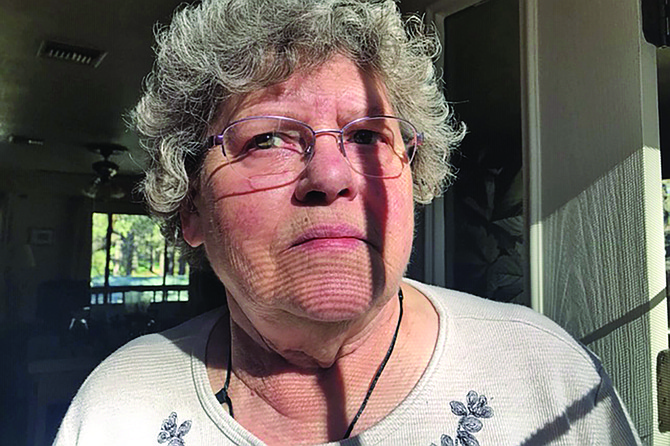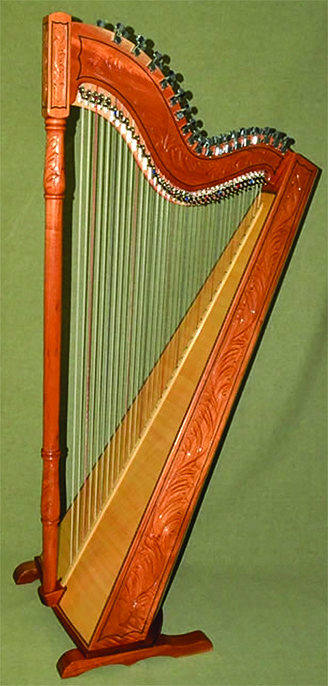 Facebook
Facebook
 X
X
 Instagram
Instagram
 TikTok
TikTok
 Youtube
Youtube

I’m halfway up Mount Laguna, walking off the Sunrise Highway into a little house on the edge of the forest. Through the gate, up redwood steps, through another gate.
An elderly lady appears at the other side of a metal mesh door.
“Phyllis?” I say.
“Of course. Please come in,” she says.
One thing I know: If I were a harp player, this would be like entering the holy of holies. Because Phyllis Robinson, her husband Robbie, and their neighbor Susan Raimond have been making this spot in the Cuyamaca National Forest a focus for harpists worldwide for 42 years. This little cluster of houses is where harp builders, harp string-makers, and even a harp-playing animal therapist have created an internationally-recognized hub for the harp world. (The therapist is Susan. She actually composes tunes to play to disturbed animals.)

“This all began,” says Phyllis, “when Robbie was posted to Rio. State Department. He had to make a trip to Paraguay. That’s where he heard the Paraguayan harp. He fell in love. He bought one. When we got back, he pulled it all apart, and taught himself to make them. That’s what he became: a harp maker, right here.”
He also started the Folk Harp Journal. And then the International Society of Folk Harpers and Craftsmen. And he kept making and selling his Paraguayan harps for about $500 each.
The thing about harps is people have been playing them for at least 5000 years. You think of medieval damsels and minstrels. Not exactly rock and roll. So, aren’t they flogging a dead horse here?
“No way,” says Mike Hensley. “Open a piano. Inside, you’ll find a harp! Same string layout. A harp is plucked. Apart from that they’re the same.” And, he points out, people like the Beatles actually used harps. Think “She’s Leaving Home.” Or the Beach Boys, “Wouldn’t It Be Nice.” (They say Brian Wilson created the harp sound by actually plucking the strings inside his piano).
Hensley is one of Phyllis’s longtime harp string makers who’s here packing orders every night. Because making harp strings has become their main business, ever since Robbie died.
“We have our little factory downstairs, in my basement,” says Phyllis. “We make hundreds of different strings for harp players around the world.”
“I’m just finishing up an order for Pakistan for 200 sets of strings,” says Hensley. “We send large amounts to Indonesia, Malaysia, Australia, as well as here in the US ”
One of the biggest harp-playing continents they send harp equipment to is Africa. “We get a lot of orders for strings for the kora, which is a type of harp in West Africa,” says Phyllis.
“And it’s all done by hand,” says Hensley. “We have to warm the core nylon, stretch it to its appropriate length, twist on the outer wrap. Each string has to have the correct vibrating length.”
What’s so encouraging is that this truly cottage San Diego industry has not been co-opted by automated machines in some massive corporation. Who knew half the harp world depended on Phyllis’s basement?


I’m halfway up Mount Laguna, walking off the Sunrise Highway into a little house on the edge of the forest. Through the gate, up redwood steps, through another gate.
An elderly lady appears at the other side of a metal mesh door.
“Phyllis?” I say.
“Of course. Please come in,” she says.
One thing I know: If I were a harp player, this would be like entering the holy of holies. Because Phyllis Robinson, her husband Robbie, and their neighbor Susan Raimond have been making this spot in the Cuyamaca National Forest a focus for harpists worldwide for 42 years. This little cluster of houses is where harp builders, harp string-makers, and even a harp-playing animal therapist have created an internationally-recognized hub for the harp world. (The therapist is Susan. She actually composes tunes to play to disturbed animals.)

“This all began,” says Phyllis, “when Robbie was posted to Rio. State Department. He had to make a trip to Paraguay. That’s where he heard the Paraguayan harp. He fell in love. He bought one. When we got back, he pulled it all apart, and taught himself to make them. That’s what he became: a harp maker, right here.”
He also started the Folk Harp Journal. And then the International Society of Folk Harpers and Craftsmen. And he kept making and selling his Paraguayan harps for about $500 each.
The thing about harps is people have been playing them for at least 5000 years. You think of medieval damsels and minstrels. Not exactly rock and roll. So, aren’t they flogging a dead horse here?
“No way,” says Mike Hensley. “Open a piano. Inside, you’ll find a harp! Same string layout. A harp is plucked. Apart from that they’re the same.” And, he points out, people like the Beatles actually used harps. Think “She’s Leaving Home.” Or the Beach Boys, “Wouldn’t It Be Nice.” (They say Brian Wilson created the harp sound by actually plucking the strings inside his piano).
Hensley is one of Phyllis’s longtime harp string makers who’s here packing orders every night. Because making harp strings has become their main business, ever since Robbie died.
“We have our little factory downstairs, in my basement,” says Phyllis. “We make hundreds of different strings for harp players around the world.”
“I’m just finishing up an order for Pakistan for 200 sets of strings,” says Hensley. “We send large amounts to Indonesia, Malaysia, Australia, as well as here in the US ”
One of the biggest harp-playing continents they send harp equipment to is Africa. “We get a lot of orders for strings for the kora, which is a type of harp in West Africa,” says Phyllis.
“And it’s all done by hand,” says Hensley. “We have to warm the core nylon, stretch it to its appropriate length, twist on the outer wrap. Each string has to have the correct vibrating length.”
What’s so encouraging is that this truly cottage San Diego industry has not been co-opted by automated machines in some massive corporation. Who knew half the harp world depended on Phyllis’s basement?
Comments